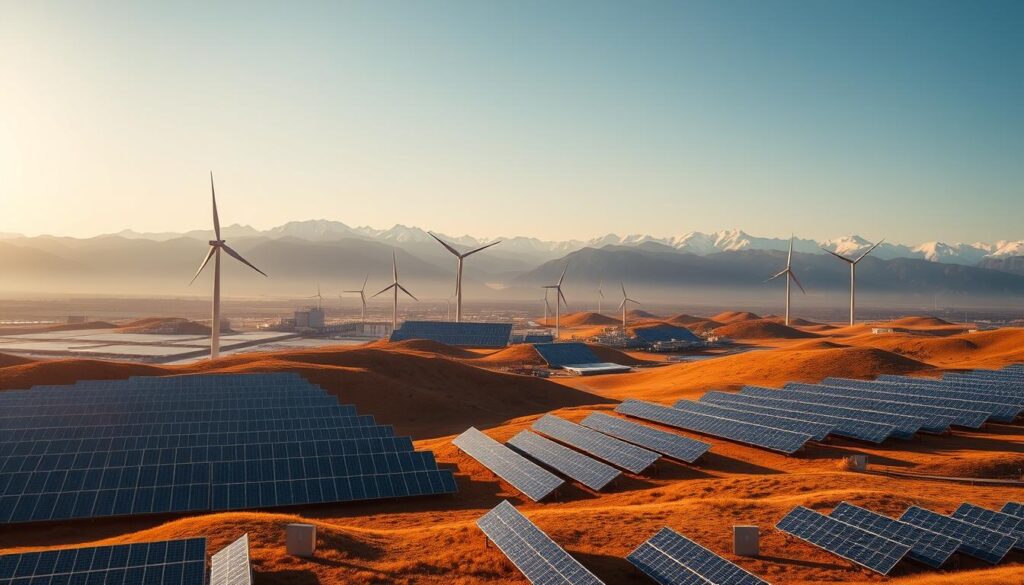Can a shift towards sustainable energy systems really make a difference in our fight against climate change?
As we face the challenges of global warming, it’s becoming increasingly clear that harnessing abundant renewable sources is crucial. Renewable sources emit little to no greenhouse gases or pollutants, making them an attractive alternative to traditional fossil fuels.
The importance of developing renewable energy infrastructure cannot be overstated. It’s a vital step towards reducing our reliance on fossil fuels and mitigating the impact of climate change.
Key Takeaways
- Renewable sources are abundant and emit minimal greenhouse gases.
- Sustainable energy systems are crucial for combating climate change.
- Developing renewable energy infrastructure is vital for a sustainable future.
- A shift towards sustainable energy can significantly reduce pollution.
- Renewable energy infrastructure plays a key role in energy security.
Understanding Renewable Energy Infrastructure
The transition to a greener economy hinges on the development and implementation of robust renewable energy infrastructure. Renewable energy includes sources like solar, wind, water, waste, and heat from the Earth, which are replenished naturally and offer a sustainable alternative to fossil fuels.
Definition and Importance
Renewable energy infrastructure refers to the systems and facilities that generate, transmit, and distribute energy from renewable sources. This infrastructure is crucial for reducing our reliance on fossil fuels, decreasing greenhouse gas emissions, and mitigating climate change. By investing in green technology solutions, we can create a more sustainable energy future.
Key Components of Infrastructure
The key components of renewable energy infrastructure include generation facilities (such as solar panels and wind turbines), transmission lines, and distribution networks. These components work together to deliver clean energy to homes, businesses, and industries. Eco-friendly infrastructure projects are essential for modernizing our energy systems and supporting economic growth.
Types of Renewable Energy Sources
There are several types of renewable energy sources, each with its unique benefits and applications. These include:
- Solar energy: Harnessed using solar panels, this energy source is ideal for both residential and commercial applications.
- Wind energy: Generated using wind turbines, wind energy is a leading source of renewable energy globally.
- Hydropower: Derived from the energy of moving water, hydropower is a reliable and renewable source of electricity.
- Geothermal energy: Utilizes heat from the Earth’s core, geothermal energy is used for heating, cooling, and electricity generation.
| Renewable Energy Source | Description | Benefits |
|---|---|---|
| Solar Energy | Harnessed using solar panels | Abundant resource, reduces electricity bills |
| Wind Energy | Generated using wind turbines | Low operational costs, creates jobs |
| Hydropower | Derived from moving water | Reliable, renewable, and flexible |
By understanding and developing clean energy development strategies, we can accelerate the transition to a more sustainable energy future. Investing in renewable energy infrastructure is a critical step towards reducing our environmental footprint and promoting economic growth.
The Benefits of Renewable Energy
The benefits of renewable energy are multifaceted, ranging from environmental protection to economic growth. As the world continues to grapple with the challenges of climate change, renewable energy emerges as a vital component in the transition to a more sustainable future.
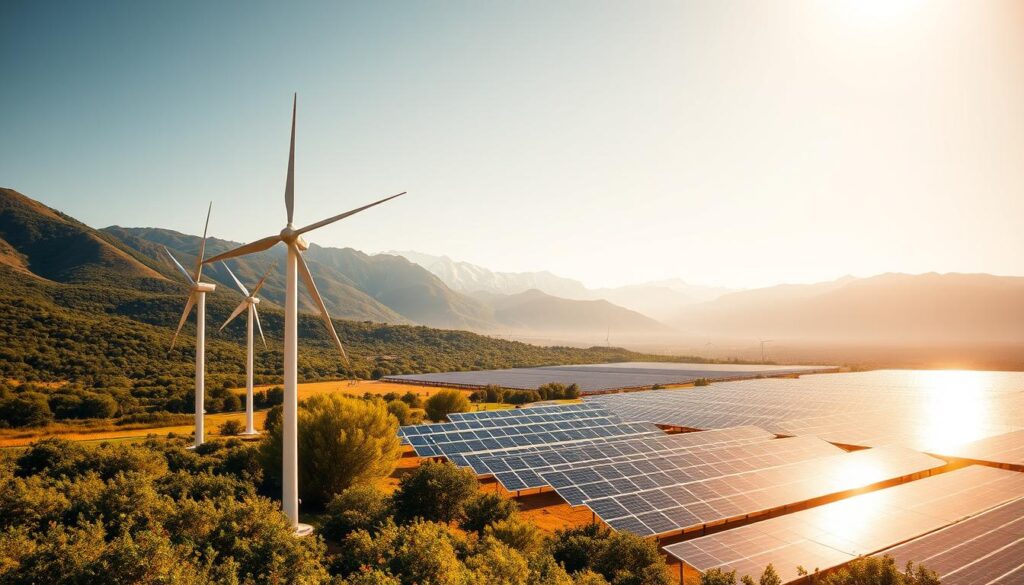
Environmental Advantages
One of the most significant benefits of renewable energy is its positive impact on the environment. Unlike fossil fuels, renewable energy sources such as solar, wind, and hydroelectric power do not emit harmful pollutants or greenhouse gases, contributing to cleaner air and water. As Mark Z. Jacobson, a renowned expert in renewable energy, notes, “Transitioning to 100% renewable energy is crucial for mitigating climate change and improving public health.”
“The evidence is clear: renewable energy is a key driver of a healthy and sustainable economy.”
Renewable energy can significantly reduce carbon emissions, helping to combat global warming. According to the United Nations, a rapid transition to renewable energy is essential for meeting global climate goals.
Economic Growth Opportunities
Beyond its environmental benefits, renewable energy also presents substantial economic opportunities. The renewable energy sector is creating jobs at a rapid pace, with over 11 million people employed globally in 2020, according to the International Renewable Energy Agency (IRENA). Investing in renewable energy can stimulate local economies and provide new opportunities for economic growth.
- Job creation in manufacturing, installation, and maintenance
- Stimulating local economies through investment
- Diversifying energy sources to improve energy security
Moreover, renewable energy projects can attract significant investment, driving innovation and competitiveness. As noted by experts at World Civil Society, green infrastructure is becoming increasingly important for sustainable development.
Energy Independence
Renewable energy can also enhance energy independence by reducing reliance on imported fuels. This can improve energy security, particularly for countries with limited energy resources. By harnessing local renewable energy sources, communities can become more self-sufficient and resilient.
“Energy independence is not just about security; it’s also about economic resilience.” By diversifying energy sources and promoting local generation, renewable energy can help mitigate the risks associated with price volatility and supply disruptions.
Types of Renewable Energy Technologies
The transition to a sustainable future is driven by diverse renewable energy technologies. These technologies are crucial for reducing our reliance on fossil fuels and mitigating climate change. In this section, we will explore various types of renewable energy technologies that are making a significant impact.
Solar Energy Systems
Solar energy systems harness energy from the sun using photovoltaic (PV) panels or solar thermal systems. These systems are becoming increasingly efficient and affordable, making them a popular choice for both residential and commercial applications. For instance, solar energy systems can be integrated into building design to provide both energy efficiency and aesthetic appeal.
Wind Turbine Farms
Wind turbine farms, or wind farms, are collections of wind turbines that generate electricity on a large scale. These turbines convert the kinetic energy of the wind into electrical energy, providing a clean and renewable source of power. The Gansu Wind Farm in China is one of the largest wind farms in the world, demonstrating the potential of wind energy to meet significant energy demands.
Hydropower Facilities
Hydropower facilities harness the energy of moving water to generate electricity. The Three Gorges Dam in China is a notable example of a large-scale hydropower project that has significantly contributed to renewable energy production. Hydropower is a reliable and renewable source of energy, but it also requires careful consideration of environmental and social impacts.
Geothermal Energy Applications
Geothermal energy applications utilize the heat from the Earth’s interior to produce electricity or provide heating and cooling. The Hellisheiði Power Station in Iceland is a prominent example of geothermal energy production, showcasing the potential of this technology in regions with significant geothermal activity. Geothermal energy is a stable and reliable source of renewable energy.
These renewable energy technologies are vital components of modern energy infrastructure and sustainable infrastructure development. As we continue to transition towards a more sustainable future, the role of these technologies will only continue to grow. For more information on how these technologies are shaping the future, visit World Civil Society.
Current State of Renewable Energy Infrastructure in the U.S.
The current landscape of renewable energy in the U.S. is characterized by substantial growth, driven by increasing investments and technological advancements.
Investment Trends
The U.S. is seeing a significant surge in investments in renewable energy infrastructure. According to recent trends, investments in clean energy have been on the rise, with both domestic and international investors showing keen interest. This influx of capital is crucial for the development and implementation of new renewable energy projects.
In 2022, the U.S. witnessed a record investment in renewable energy, with over $55 billion invested in solar and wind energy projects alone. This trend is expected to continue, driven by the decreasing costs of renewable technologies and the increasing demand for clean energy.
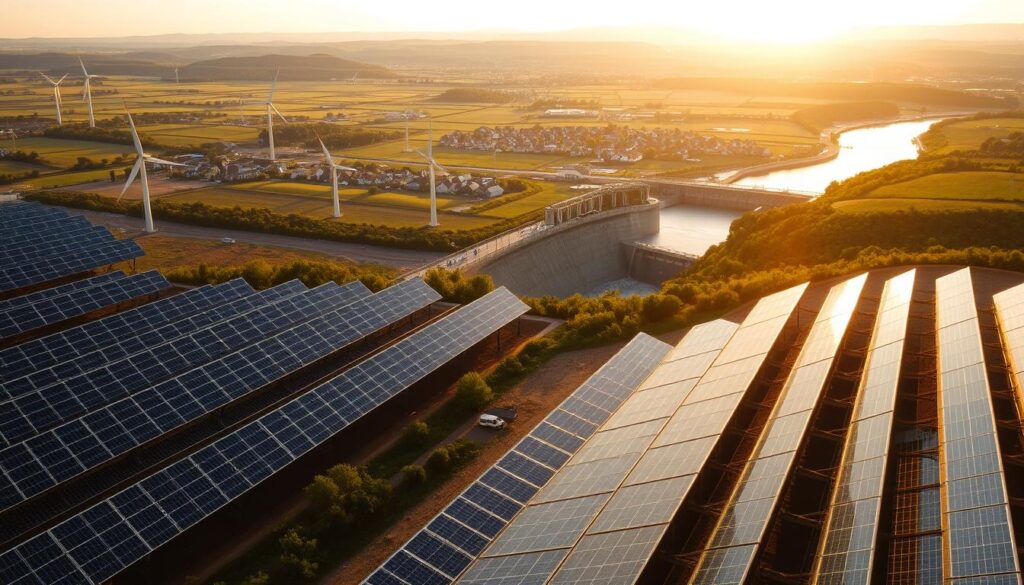
Regional Development Differences
Despite the overall growth in renewable energy infrastructure, there are significant regional differences in development. States like California, Texas, and Iowa are leading the way in renewable energy adoption, driven by favorable policies and abundant natural resources.
In contrast, other regions lag behind due to various factors, including regulatory hurdles and lack of infrastructure. Understanding these regional differences is crucial for policymakers and investors to target areas that need support and to replicate successful models in other regions.
Key Players in the Industry
The renewable energy industry in the U.S. is characterized by a diverse range of players, from large corporations to small startups. Companies like Vestas, Siemens Gamesa, and SunPower are among the key players driving innovation and development in the sector.
Additionally, government initiatives and public-private partnerships play a vital role in advancing renewable energy infrastructure. Collaborative efforts between different stakeholders are essential for overcoming the challenges faced by the industry and for achieving a sustainable energy future.
Challenges Facing Renewable Energy Infrastructure
The transition to renewable energy is not without its challenges, including financial, technological, and regulatory issues. As the world increasingly adopts eco-friendly infrastructure projects, it is crucial to address these challenges to ensure a smooth transition.
Funding and Investment Issues
One of the significant challenges facing renewable energy infrastructure is the high upfront costs associated with alternative energy solutions. Despite the long-term savings, the initial investment can be prohibitive for many investors.
To mitigate this, various financing models have been developed, including power purchase agreements (PPAs) and green bonds. These financial instruments help reduce the risk for investors and make renewable energy projects more viable.
| Financing Model | Description | Benefits |
|---|---|---|
| Power Purchase Agreements (PPAs) | Contract between a generator and a buyer for the sale of electricity | Reduces risk for investors, stable revenue stream |
| Green Bonds | Bonds issued specifically for renewable energy projects | Attracts environmentally conscious investors, lower cost of capital |
Technological Barriers
Technological limitations also pose a significant challenge. The efficiency of renewable energy technologies, such as solar panels and wind turbines, is improving, but there is still a need for further innovation to make these technologies more cost-effective and efficient.
Advancements in technology are crucial for overcoming these barriers. For instance, improvements in energy storage technologies can help stabilize the grid and make renewable energy more reliable.
Policy and Regulatory Hurdles
Policy and regulatory frameworks play a critical role in the development of renewable energy infrastructure. However, inconsistent policies and regulatory hurdles can create uncertainty and discourage investment.
Streamlining regulatory processes and implementing consistent policies can help mitigate these challenges. Governments can provide incentives and support for renewable energy projects, making them more attractive to investors.
The Role of Government in Renewable Energy
The role of government in renewable energy is multifaceted, involving incentives, regulations, and initiatives that drive the transition to a sustainable energy future. Governments around the world are recognizing the importance of renewable energy and are taking significant steps to promote its development.
Incentives and Subsidies
Governments offer various incentives and subsidies to encourage investment in renewable energy. These can include tax credits, grants, and low-interest loans that help reduce the financial burden on companies and individuals looking to invest in renewable energy technologies. For instance, the EY report highlights six ways governments can drive the green transition, including providing financial incentives for renewable energy projects.
Some of the key incentives include:
- Tax credits for renewable energy production
- Grants for research and development in renewable energy technologies
- Low-interest loans for renewable energy projects
Regulatory Frameworks
A well-designed regulatory framework is crucial for the development of renewable energy. Governments can establish policies that create a favorable environment for renewable energy investment. This includes setting renewable portfolio standards (RPS), which require utilities to generate a certain percentage of their electricity from renewable sources.
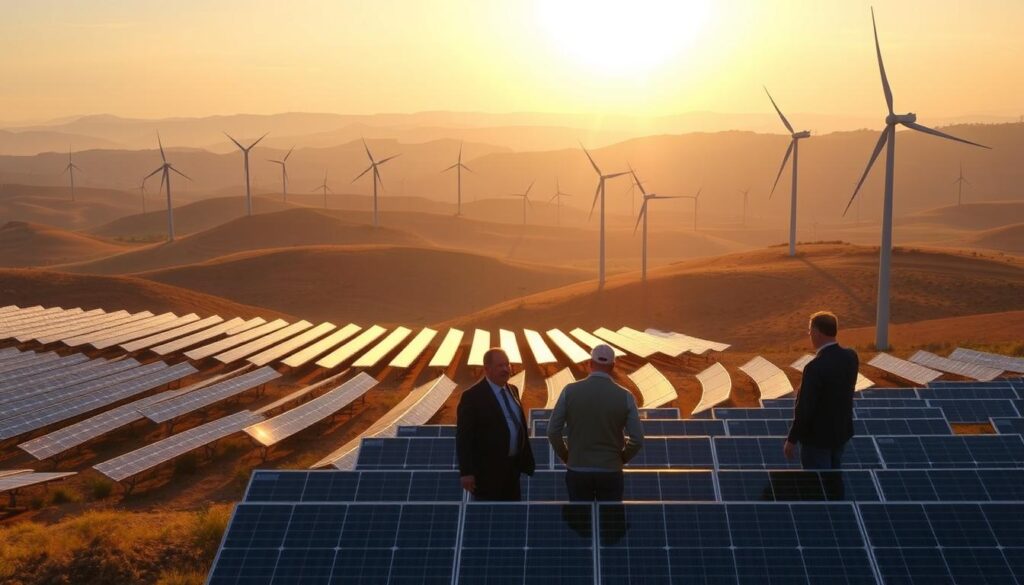
Regulatory frameworks also involve streamlining the permitting process for renewable energy projects, reducing bureaucratic hurdles, and ensuring that projects are implemented efficiently.
Federal and State Initiatives
Both federal and state governments play a significant role in promoting renewable energy. At the federal level, initiatives such as the Renewable Electricity Production Tax Credit have been instrumental in driving investment in renewable energy. State-level initiatives, such as California’s renewable energy goals, have also been pivotal in promoting the adoption of renewable energy technologies.
| Initiative | Description | Impact |
|---|---|---|
| Renewable Electricity Production Tax Credit | Federal tax credit for renewable energy production | Driven investment in wind and solar energy |
| California’s Renewable Energy Goals | State-level targets for renewable energy adoption | Increased adoption of solar and wind energy in California |
In conclusion, governments have a multifaceted role in promoting renewable energy through incentives, regulatory frameworks, and initiatives at both the federal and state levels. By understanding and leveraging these tools, governments can drive the transition to a more sustainable energy future.
Innovations in Renewable Energy Infrastructure
Innovations in renewable energy infrastructure are revolutionizing the way we generate and consume energy. The integration of cutting-edge technologies is enhancing the efficiency and reliability of sustainable energy systems.
Smart Grid Technologies
Smart grid technologies are transforming the energy landscape by providing real-time monitoring and management of energy distribution. These technologies enable utilities to optimize energy supply and demand, reducing waste and improving grid resilience. Advanced grid management systems are being implemented to ensure a stable and efficient energy supply.
Energy Storage Solutions
Energy storage solutions are critical for addressing the intermittency of renewable energy sources. Advanced battery technologies are being developed to store excess energy generated during peak production periods, ensuring a stable energy supply during periods of low production.
Blockchain in Energy Management
Blockchain technology is being explored for its potential to enhance energy management. It enables secure, transparent, and efficient transactions, facilitating peer-to-peer energy trading and grid management. Blockchain-based systems can improve the reliability and security of renewable energy infrastructure.
These innovations are pivotal in driving the transition towards a more sustainable and resilient energy future. By leveraging green technology solutions, we can enhance the efficiency, reliability, and sustainability of renewable energy systems.
Integrating Renewable Energy into Existing Grids
With the rise of renewable energy, the need to seamlessly integrate it into our existing grids has become more urgent than ever. This integration is crucial for ensuring a stable and efficient energy supply that can meet the increasing demand for clean energy.
Modernizing Infrastructure
One of the primary steps in integrating renewable energy into existing grids is modernizing the infrastructure. This involves upgrading old grid systems to accommodate new energy sources, enhancing the grid’s flexibility, and improving its ability to manage variable energy inputs from sources like solar and wind.
Smart technologies play a vital role in this modernization process, enabling real-time monitoring and management of energy distribution. By leveraging advanced technologies, grid operators can optimize energy flow, predict and respond to demand fluctuations, and reduce the likelihood of power outages.
Grid Reliability and Resilience
Ensuring grid reliability and resilience is another critical aspect of integrating renewable energy. As the grid becomes more complex with the addition of diverse energy sources, maintaining its stability is paramount. This requires advanced forecasting tools, energy storage solutions, and grid management systems that can handle the variability of renewable energy.
The use of energy storage systems is particularly important, as they can store excess energy generated by renewable sources during periods of low demand and release it when demand is high, thereby stabilizing the grid.
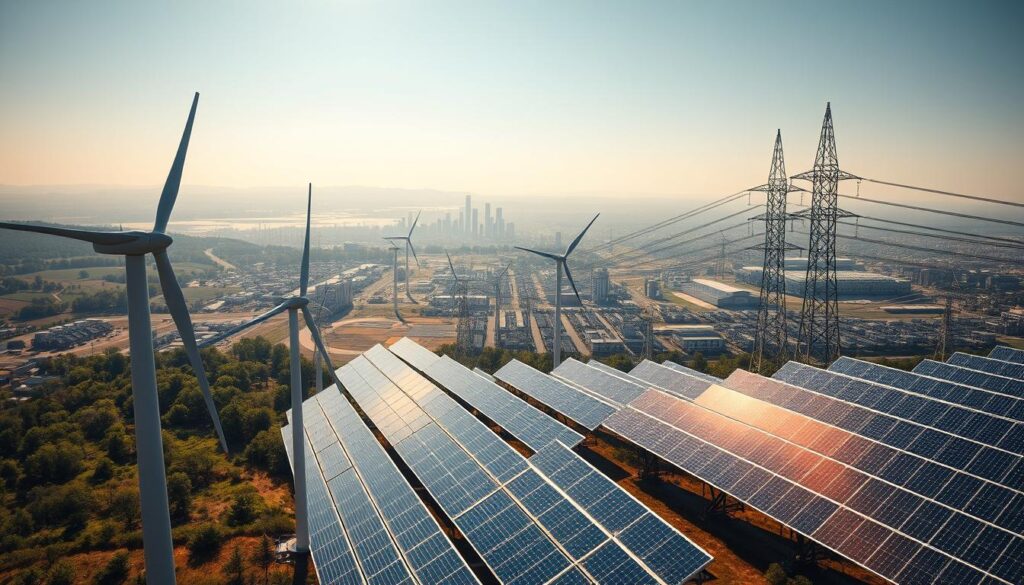
Smart Meter Implementation
The implementation of smart meters is a key component of grid modernization. Smart meters provide real-time data on energy consumption, enabling utilities to optimize energy distribution and consumers to make informed decisions about their energy usage.
By facilitating two-way communication between utilities and consumers, smart meters help in managing peak demand, reducing energy waste, and promoting energy efficiency. This not only benefits consumers but also contributes to the overall reliability and resilience of the grid.
The Future of Renewable Energy Infrastructure
The future of renewable energy infrastructure looks bright, with significant growth predicted in the coming years. As the world continues to transition towards cleaner energy sources, the demand for alternative energy solutions is expected to skyrocket.
Predictions for Growth
Experts forecast that renewable energy will become a major source of global energy, driven by declining technology costs and increasing investment in sustainable infrastructure development. Some key predictions include:
- A significant increase in solar and wind energy capacity
- Growing adoption of energy storage technologies
- Expansion of smart grid systems to enhance energy efficiency
For more information on the current state of renewable energy transmission infrastructure, visit the Department of the Interior’s website.
Emerging Technologies to Watch
Several emerging technologies are set to revolutionize the renewable energy landscape. These include:
- Advanced solar panel technologies that offer higher efficiency rates
- Floating wind turbines that can be installed in deeper waters, unlocking new areas for wind energy production
- Energy storage innovations that improve the reliability and stability of renewable energy sources
The Role of Community Initiatives
Community initiatives play a crucial role in promoting the adoption of renewable energy. These initiatives can take many forms, including:
- Community solar programs that allow multiple individuals to benefit from a single solar array
- Local renewable energy cooperatives that empower communities to take ownership of their energy production
- Educational programs that raise awareness about the benefits of renewable energy
By working together, communities can drive the transition to a more sustainable energy future.
Case Studies of Successful Infrastructure Projects
Across the U.S., pioneering renewable energy infrastructure projects are setting new standards. These projects not only demonstrate the feasibility of renewable energy but also highlight the challenges and successes encountered along the way.
California Solar Initiative
The California Solar Initiative (CSI) is a landmark program that has significantly contributed to the adoption of solar energy in California. Launched in 2006, the CSI aimed to install 3,000 megawatts of solar capacity by 2016. The initiative provided rebates and incentives to homeowners and businesses, making solar energy more accessible.
Key Achievements:
- Installed over 1,940 megawatts of solar capacity.
- Stimulated a significant reduction in solar panel costs.
- Created thousands of jobs in the solar industry.
Texas Wind Energy Projects
Texas is a leader in wind energy production, with numerous wind farms across the state. The Competitive Renewable Energy Zone (CREZ) initiative was instrumental in developing the necessary transmission infrastructure to support wind energy projects.
| Project | Capacity (MW) | Location |
|---|---|---|
| Roscoe Wind Farm | 781 | Roscoe, Texas |
| Stanton Wind Farm | 120 | Stanton, Texas |
| Buffalo Gap Wind Farm | 523 | Abilene, Texas |
New York’s Renewable Energy Goals
New York has set ambitious renewable energy targets, aiming to generate 70% of its electricity from renewable sources by 2030. The state’s initiatives include large-scale solar and wind projects, as well as investments in energy efficiency.
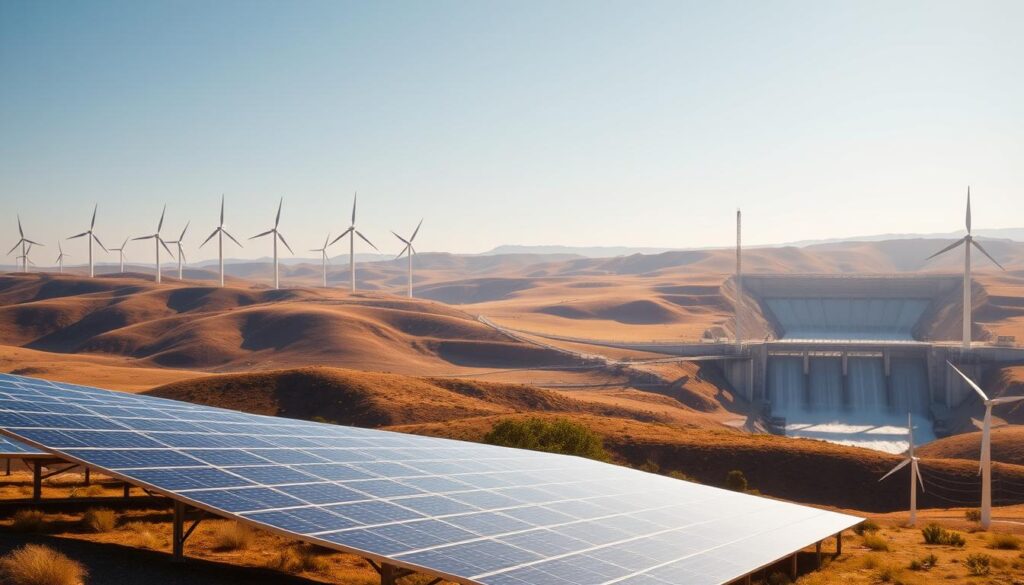
Key Initiatives:
- Developing offshore wind projects.
- Expanding solar energy capacity.
- Enhancing energy storage capabilities.
These case studies illustrate the diverse approaches to developing renewable energy infrastructure across the United States. By examining the successes and challenges of these projects, we can gain valuable insights into the future of renewable energy.
The Importance of Public Awareness and Education
The success of renewable energy initiatives heavily relies on public awareness and understanding. As the world transitions towards cleaner energy sources, educating the public about the benefits and importance of renewable energy becomes crucial.
Effective community engagement strategies are vital for increasing public awareness. These can include organizing workshops, seminars, and community events that provide information about renewable energy technologies and their advantages. For instance, a community solar program can educate residents about the benefits of solar energy and how they can participate.
Community Engagement Strategies
Community engagement is not just about disseminating information; it’s also about listening to the concerns and ideas of the community. By doing so, renewable energy projects can be tailored to meet the specific needs and concerns of the local population. This approach not only fosters support but also ensures that the projects are sustainable and beneficial to the community.
- Organizing community events and workshops
- Creating educational materials and resources
- Engaging with local schools and universities
For more information on the importance of education in renewable energy, visit https://getsolarlabels.com/blog/the-importance-of-solar-energy-education-and-awareness/.
Promoting Sustainable Practices
Promoting sustainable practices is another key aspect of public education. This involves encouraging individuals and communities to adopt environmentally friendly behaviors and technologies. By promoting sustainable practices, we can reduce our reliance on fossil fuels and decrease carbon emissions.
Some effective ways to promote sustainable practices include:
- Implementing recycling programs
- Encouraging the use of energy-efficient appliances
- Promoting the use of public transport, cycling, or walking
Educational Programs and Resources
Developing comprehensive educational programs and resources is essential for enhancing public understanding of renewable energy. This can include curriculum development for schools, online courses, and informational websites. By providing accessible educational resources, we can empower individuals to make informed decisions about their energy use.
For example, initiatives like engineering innovation for communities can provide valuable resources and knowledge, promoting a culture of sustainability and innovation.
By focusing on public awareness and education, we can accelerate the transition to a more sustainable energy future. It’s about creating a culture that values and understands the importance of renewable energy, thereby supporting the widespread adoption of green technology solutions.
Collaborations and Partnerships in the Sector
Effective collaborations are key to advancing eco-friendly infrastructure projects. The renewable energy sector is witnessing a significant transformation due to strategic partnerships among various stakeholders.
These collaborations are not limited to any one type; they encompass a broad range of partnerships, including public-private partnerships, international collaborations, and nonprofit initiatives. Each of these plays a crucial role in driving innovation and investment in renewable energy.
Public-Private Partnerships
Public-private partnerships (PPPs) are instrumental in delivering large-scale renewable energy projects. By combining the strengths of both public and private sectors, PPPs can mobilize significant investment and expertise. For instance, the World Bank’s Public-Private Partnerships in Energy initiative has facilitated numerous projects worldwide, showcasing the potential of PPPs in advancing renewable energy infrastructure.
Some key benefits of PPPs include:
- Increased efficiency in project delivery
- Risk sharing between public and private sectors
- Access to advanced technology and expertise
| Partnership Type | Key Features | Benefits |
|---|---|---|
| Public-Private Partnerships | Combines public and private sector strengths | Increased efficiency, risk sharing, access to technology |
| International Collaborations | Involves cross-border partnerships | Global knowledge sharing, access to new markets |
| Nonprofit Initiatives | Driven by mission-oriented organizations | Community engagement, advocacy, and education |
International Collaborations
International collaborations are vital for the global advancement of renewable energy. These partnerships facilitate the sharing of knowledge, technology, and best practices across borders. Countries can learn from each other’s experiences, accelerating the global transition to renewable energy.
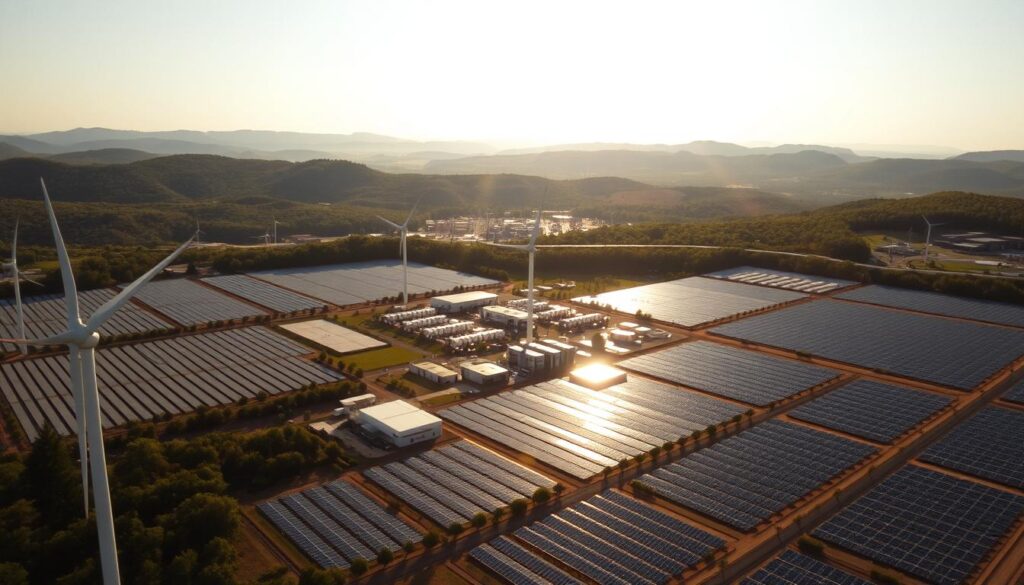
Nonprofit Initiatives
Nonprofit organizations play a significant role in promoting renewable energy through community engagement, advocacy, and education. Their initiatives often focus on raising awareness about the benefits of renewable energy and supporting local projects.
By fostering a collaborative environment, the renewable energy sector can continue to grow and develop, driving us towards a more sustainable future.
Economic Impact of Renewable Energy Infrastructure
The economic impact of renewable energy infrastructure is multifaceted, influencing job markets, local economies, and long-term financial stability. As the world transitions to renewable energy sources, understanding these economic implications is crucial for stakeholders at all levels.
Job Creation Statistics
One of the most significant economic benefits of renewable energy infrastructure is job creation. According to recent studies, the renewable energy sector has the potential to create millions of jobs globally across various industries, including manufacturing, installation, and maintenance. For instance, investing in renewable energy can stimulate local economies by creating new employment opportunities.
Key job creation statistics include:
- Renewable energy industries have created over 11 million jobs worldwide.
- Solar and wind energy are among the top sectors for job creation in the renewable energy industry.
- Job growth in renewable energy is outpacing traditional energy sectors in many regions.
Local vs. National Economic Effects
The economic effects of renewable energy infrastructure can be observed at both local and national levels. Locally, renewable energy projects can stimulate economic growth by increasing demand for local goods and services, thereby boosting local businesses. Nationally, a robust renewable energy sector can reduce reliance on imported fuels, improving energy security and potentially reducing trade deficits.
As noted by industry experts, “The transition to renewable energy is not just an environmental necessity but also an economic opportunity that can drive growth and development at multiple levels.” This sentiment is echoed in various studies highlighting the benefits of sustainable infrastructure development.
Long-term Financial Benefits
Investing in renewable energy infrastructure offers substantial long-term financial benefits. These include reduced operational costs due to lower maintenance and fuel costs, as well as potential revenue streams from selling excess energy back to the grid. Moreover, renewable energy can mitigate the financial risks associated with price volatility in fossil fuel markets.
“Renewable energy can provide a stable source of energy at a fixed cost, shielding economies from the unpredictability of fossil fuel prices.”
For more insights on the types of engineering best suited for renewable energy projects, you can explore resources such as discussions on engineering disciplines.
Conclusion: The Path Forward for Renewable Energy
As the world shifts towards a more sustainable future, renewable energy infrastructure plays a vital role in reducing our reliance on fossil fuels. By 2025, up to 90% of new global energy capacity is expected to come from renewable sources, with projected investments reaching $728 billion.
The transition to green technology solutions is gaining momentum globally. The European Union aims to increase the share of renewables in its energy consumption to 42.5% by 2030, while the UK is on track to meet its goal of 95% low-carbon electricity by 2030. For more information on the global energy landscape, visit Horton International’s report on renewable energy trends.
Key to a Sustainable Future
Continued investment in renewable energy infrastructure is crucial for achieving a sustainable future. This investment will not only drive economic growth but also help mitigate climate change. Collective responsibility is essential in promoting the adoption of green technology solutions.
Building a Greener Tomorrow
As nations like the US and China target ambitious renewable energy goals, it’s clear that a global commitment to sustainability is underway. Australia’s aim to expand its renewable energy mix to 82% by 2030 is another example of this trend. By working together, we can create a cleaner, more sustainable world powered by renewable energy.
